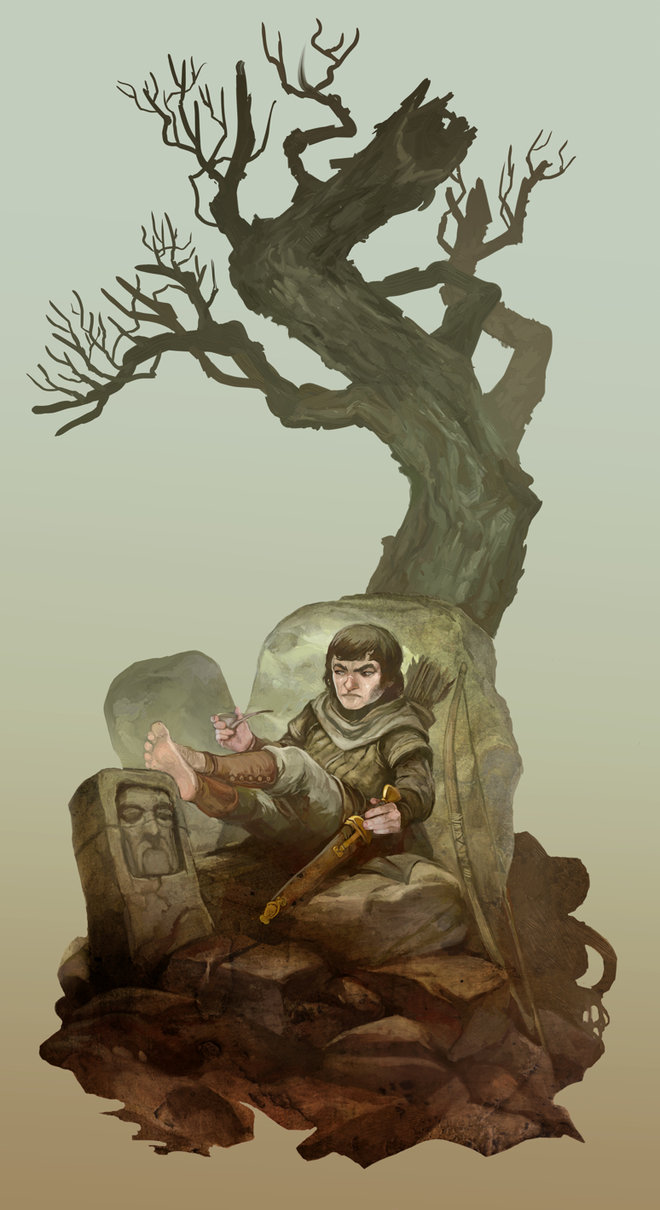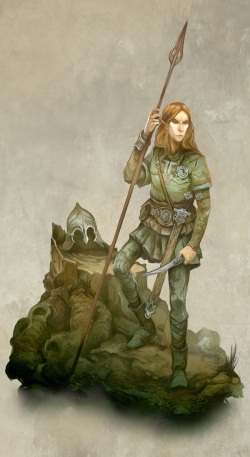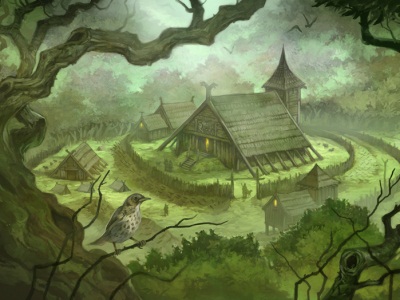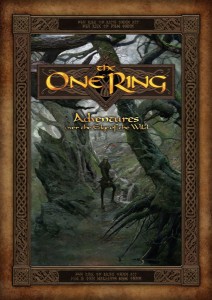Publisher: Cubicle 7
Audience: GM/Players
Price: Print+PDF – $59.99
Pages: Slip Cased Set
Tankard Rating: 4.5/5
The One Ring: Adventures over the Edge of the Wild
The One Ring (TOR) comes in a slip covered case and contains the following items:
- 192 page Adventurer’s Book
- 144 page Loremaster’s Book
- Loremaster’s Map
- Adventurer’s Map
- Six 6-sided dice and One 12 sided die
The One Ring: Adventures over the Edge of the Wild is the first of three planned core releases for the game with other supplements to become available over time. This portion starts in the year 2946 of the Third Age in Middle-earth. This places it about five years after the Battle of the Five Armies which was at the end of The Hobbit. In addition the areas described all focus on the Wilderlands region which includes Misty Mountains, Mirkwood, the Lonely Mountain and the town of Esgaroth on Long Lake. The future releases will expand the geographical area and cultures available to be played.
Adventurer’s Book
The Adventurer’s Book is geared for the player of The One Ring RPG and provides an intro that does not assume future roleplaying experience, including a short example of play. Next up is the section on character generation where one can choose from one of six cultures – Barding, Beornings, Dwarves of the Lonely Mountain, Elves of Mirkwood, Hobbits of the Shire, or Woodmen of Wilderlands. This section provides information on all the customizations a player can make for their character.

Artist: Jon Hodgson
The following section goes into the mechanics with a more detailed look at the attributes, skills, traits and introduces the endurance and hope mechanics of the system. This section also contains more information on the gear you can select and how encumbrance functions in TOR.
Continuing on in the Adventurer’s Book we reach the Character Development section. Here we learn about valor and wisdom, virtues, rewards and finishes with life and death in the game, states of health and how one gets better if they are injured.
The fifth section provides additional information on action resolution, how tasks are resolved, the dice mechanics and the importance of the journey. Traveling through various areas require a number of checks which can lead to a hazard as you travel. Combat is also addressed in this section of the Adventurer’s Book as well.
The final section of the book talks of the Fellowship Phase which is the opportunity the characters have to recover from their journeys and adventures through the Wilderlands. It covers how the heroes can develop their character further during these phases.
The Adventurer’s Book includes a pre-generated character for each culture and also a blank character sheet for creating your own characters. The book does include an Index.
Loremaster’s Book
Within the Loremaster’s Book we find a section that explains what the Loremaster’s role is in playing the game before moving into the next section on the Game Mechanics.

Artist: Jon Hodgson
The Game Mechanics section takes a much closer look at the structure of running a game including the Adventuring Phase and Fellowship Phase. Dice rolling mechanics are covered, resolving actions, how to run Loremaster characters within the game. How characters advance and how to award them is included as well as more details on the Journey aspect of the adventure and how to plot the character’s journey to determine how many hazard checks they will need to make. Combat finishes off this section with a more detailed look at it from the Loremaster’s perspective.
The third section is most akin to the bestiary section. The ever present Shadow of Middle-earth is covered and the influence of the Shadow leading to corruption. Then the primary threats in the Wilderland region of the Middle-earth are covered which include orcs, trolls, spiders and a few more creatures.
The following section gives the reader more information on creating a campaign within the world of Middle-earth. It tells about the region, the timeline and some of the world events in that region to help provide the Loremaster with enough background information to start their own campaign.
The final section of this book is an adventure called The Marsh Bell to help a Loremaster have something to work with for their first adventure using this rule-set.
Accessories
There are two fold-out maps that come in the slipcover, one for the Loremaster which has hexes on it and keyed to indicate difficulty of passage and whether the land is affected by the Shadow or not. This is to allow for the calculation of journeys the fellowship may embark on. The Adventurer’s map shows the same geographical area, but without the hexes and difficulty of terrain keyed on it.
The game also comes with its own dice which have some notations specific to TOR mechanics. There are six 6 sided dice with the numbers 1-3 marked in outline and a tengwar rune on the number 6. The d12 has the number 12 replaced with the Gandalf Rune and the 11 replaced with the Sauron eye.
Mechanics Summary
Characters have three main attributes – Body, Heart and Wits. They also have a collection of skills and traits. Instead of hit points the characters have endurance scores which have points removed when they are hit during combat. If you fall below a fatigue score then the character becomes weary which has an effect on the dice rolled during combat. A character also has hope points that come from a limited pool that are primarily spent to allow an attribute score to be added as a bonus to a skill or combat check.
A character also tracks their Shadow rating. One accumulates shadow points in several different ways, once the number of hope points falls to less than or equal to their shadow score they become miserable. If a character who is miserable has a Sauron eye show up on the d12 they suffer from madness and temporarily lose control of their character.
Skill resolution is handled by rolling a number of d6 dice, plus the d12 feat die. You roll a number of d6 dice equal to the number of ranks you have in the skill. For example, if you have two ranks in Athletics and need to make a skill check you would roll 2d6 + d12 to try to beat a target number (TN). An average TN is a fourteen. There are varying degrees of success indicated by rolling a 6 (with the Tengwar rune) on the 6 sided dice. One 6 is a great success and two 6’s is an extraordinary success. Rolling a Gandalf rune is an auto success and rolling a Sauron eye most often means the result on the d12 counts as a zero.
Combat resolution works very similar to skill resolution. A character has a number of ranks in their weapon of choice and that indicates the number of 6 sided dice they roll. The TN they roll against is determine by their stance in combat. Which can range from an aggressive stance to defensive to ranged combat. If the roll also exceeds the edge rating of the weapon then the opposing side needs to roll a protection check to avoid being wounded. The armor one wears helps determine how many d6’s are rolled for the protection check.
The Good and the Bad
The One Ring is a very solid offering. The artwork in the books is outstanding and goes far in putting the reader in a Middle-earth mindset. The art really sets the imagination running as you make your way through the books.

Artist: Jon Hodgson
The mechanics also do a very good job of emulating feel of Middle-earth adventuring as well. From the emphasis on the journey itself and not just the destination much like a fair amount of Tolkein’s work. The addition of the Hope and Shadow mechanics also serve to further reinforce that there is this constant Shadow in the world that seeks to drain your strength or corrupt your being. These feelings can be difficult to emulate through rules, but I think The One Ring has done a great job at getting this feeling from the game.
I have play tested the combat several times against varying party sizes and numbers and types of monsters. Once you get used to the combat round it flows very quickly. Since you fight by stance there is less reliance on precise tactical movement allowing you to narrate freely and also greatly reduces the need of a battle mat for play. Battles can range from trying to wear down someone’s endurance to rapid turns due to wounds being scored against your opponent. In one test battle against a troll the heroes barely pulled it off, running it again later and the troll went down quickly.
The largest complaint I have is in regards to the book layout. I find myself frequently hunting for some rule information and the information is often not near the section you would expect it to be. This sometimes gives it a disjointed feel – the rules are all there, they just aren’t always logically grouped together. This is a relatively small complaint and not a game breaker by any means.
The One Ring is a great release. If you have an affinity for Middle-earth gaming with a relatively rules-light rule set and enjoy excellent artwork it is well worth picking this product up. It is sure to provide enjoyment to long time Middle-earth fans or even those new to Middle-earth gaming.
Tankard Rating
4.5 tankards out of 5 tankards.






